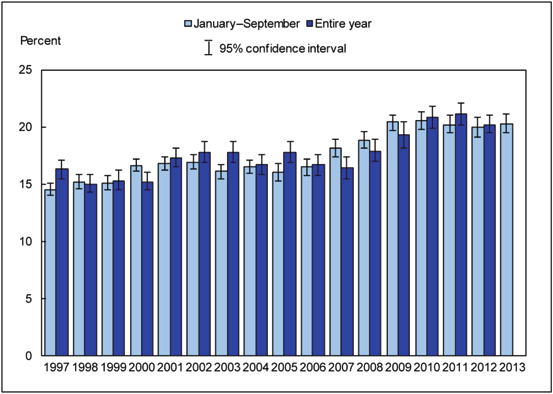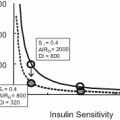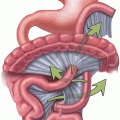Fig. 5.1
Percentage of adults aged 18 and over who met the 2008 federal physical guidelines for aerobic activity through leisure-time aerobic activity: United States 1997–2012. (Data from the CDC/National Center for Health Statistics (NCHS), National Health Interview Survey, 1997–2002, Sample Adult Core Component)

Fig. 5.2
Percentage of adults aged 18 and over who met the 2008 federal physical activity guidelines for both aerobic and muscle-strengthening activities through leisure-time aerobic and muscle-strengthening activities: United States, 1997 to September 2013. (Data from CDC/NCHS, National Health Interview Survey, 1997 to September 2013, Sample Adult Core Component)
Table 5.1
General physical activities defined by level of intensity. The following is in accordance with CDC and ACSM guidelines. (http://www.cdc.gov/physicalactivity/everyone/measuring/index.html, http://www.cdc.gov/nccdphp/dnpa/physical/pdf/PA_Intensity_table_2_1.pdf)
Moderate intensity 3.0–6.0 METs (3.5–7 kcal/min) | Vigorous intensity Greater than 6.0 METs ( than 7 kcal/min) |
|---|---|
Walking briskly (3–4.5 mph, but not race walking) | Race walking, jogging, or running |
Swimming laps | |
Water aerobics | Tennis (singles) |
Bicycling slower than 10 miles per hour | Aerobic dancing |
Tennis (doubles) | Bicycling 10 miles per hour or faster |
Ballroom dancing | Jumping rope |
Golf—wheeling or carrying clubs | Heavy gardening (continuous digging or hoeing) |
Hiking uphill or with a heavy backpack |
For decades the CDC and medical societies such as the American College of Sports Medicine (ACSM) and American Heart Association (AHA) have worked to promote physical activity in the American population, however, the results have been disappointing at best. In part, the American population has been inundated with various recommendations from different medical societies as well as the lay press, which has lead to confusion about how much and what type of exercise is really needed on a regular basis for optimal health and fitness. When medical societies have quite differing opinions regarding the amount and intensity of activity it leads many to become frustrated . Fortunately, the AHA and the ACSM have helped to clarify the public health recommendations for physical activity. Recommendations are moderate to ensure that they are realistic and achievable, with some of the most recent recommendations in 2008. Additionally, in 2009, the ACSM also published guidelines regarding the amount of physical activity for children, adults and the elderly for weight loss and maintenance. In 1990, 2000 and 2010, physical activity recommendations have been included as a part of the public health goals within the CDC’s Healthy People Initiatives. Sadly, as the obesity epidemic continues in the USA, the public health initiatives have not made great strides in significantly impacting physical activity levels.
Definitions
Exercise and physical activity are typically used interchangeably; however, their exact definitions are distinct. Exercise is structured and repetitive physical activity designed to maintain or improve specific components of physical fitness [7, 8]. The components of physical activity include cardiorespiratory endurance, muscular strength, flexibility, and body composition. When individuals train for any activity or sport, they are performing exercise, examples include running on a treadmill, cycling or taking an aerobics class. While in comparison, the term physical activity includes all leisure and nonleisure body movements resulting in increased energy output from the resting condition [8]. Physical activity includes activities of daily living, occupational activity, transportation, and leisure [7]. Walking your dog, biking to work, vacuuming your home, and gardening are all types of physical activity. All exercise is a type of physical activity; however, all physical activity is not exercise. In short, exercise is intentional physical activity for improving health and fitness [7]. Active daily living, the goal of most health recommendations, is the implementation of physical activity as an integral and meaningful part of daily life. Not only should individuals aim to have structured physical activity daily, they should also focus on being active in nonstructured ways, such as walking to lunch or taking the stairs.
Physical fitness is also used within the literature, and is defined by measured health and skill-related assessments for cardiorespiratory fitness, muscular strength and endurance, body composition, flexibility, balance, agility, reaction time, and power [8]. Different types of exercise and physical activity will help to improve different aspects of physical fitness. For example, running or walking will improve cardiorespiratory fitness while pilates will improve flexibility, balance, and muscular strength. To improve different aspects of one’s fitness, it is important to combine a variety of activities.
Exercise can then further be split into aerobic and nonaerobic exercise. Aerobic exercise includes activities that are rhythmic in nature, using large muscle groups at moderate intensities for prolonged periods of time with the goal of keeping the heart rate elevated. The elevation in the heart rate as well as the amount of work performed during the activity determines the intensity of the exercise . The more intense the activity the more energy or calories expended per minute. Typically, intensity is evaluated in terms of metabolic equivalents (METs). METs is the unit used to estimate the amount of oxygen used by the body during physical activity [7, 8].
Moderate intensity physical activity refers to the level of effort in which a person should experience while exercising. There are a variety of definitions of moderate intensity activity and include: some increase in breathing or heart rate, a “perceived exertion” of 11–14 on the Borg scale of 6–20, 3–6 METs, and any activity that burns 3.5–7 calories per minute [7, 8]. While participating in moderate intensity activity patients should be able to hold a conversation with someone; this can be an easy guideline to help patients monitor intensity levels. Examples of moderate intensity activity include walking briskly, dancing, swimming, or bicycling. Vigorous activity levels are typically intense enough to represent a substantial challenge to an individual. With vigorous activity there will be a large increase in heart rate and breathing rate, a perceived exertion score of 15 or greater on the Borg scale of 6–20, a METs of 6 or greater and includes any activity that burns more than 7 calories per minute [7, 8]. Patients will no longer be able to hold a conversation with someone while exercising. Examples of vigorous activity include jogging, high-impact aerobic dancing, swimming continuous laps, or bicycling uphill.
Resistance activity or weight training is nonaerobic activity, which includes movements that use repeated and progressive contractions of specific muscle groups to increase muscle strength, endurance, and power. Traditional resistance training consists of lifting heavier weights with long rest periods in between. In comparison, circuit training includes lifting lighter weights with shorter rest periods in between, which allows for an aerobic component to the workout [9].
Benefits of Exercise
Physical activity and exercise are recommended as fundamental components of weight management programs by most public health agencies and scientific organizations. However, for many patients exercise is seen as a means to an end: you exercise to lose weight. When activity is not combined with other lifestyle interventions, such as dietary change, the results can be disappointing at best [10]. The real benefit of exercise and activity during weight loss is the increased caloric expenditure, which can induce greater weight loss compared with diet alone, even in patients with severe obesity [5]. Physical activity will help to prevent loss of lean body mass during weight loss and will assist with greater reductions in abdominal visceral fat [5, 9]. In addition to the role regular activity plays in active weight loss, studies demonstrate even greater benefit of regular activity in long term weight maintenance and prevention of weight regain [11]. Preventing weight regain can be more difficult than the initial weight loss process itself and physical activity is seen as a must for optimal long-term management [12, 13]. Studies of the National Weight Control Registry point to the inclusion of regular physical activity as one of the cornerstone themes for successful long-term weight management —suggesting the need for higher levels of activity than previously recommended [11]. Weight loss, weight maintenance, and prevention of weight gain are fundamental benefits of regular activity; However, they must be used in combination with diet and lifestyle change for optimal results .
The benefits of regular physical activity go well beyond weight loss and management. Studies have showed that the relative risk of death from any cause as well as from cardiovascular causes is elevated in patients who are unfit [14]. Furthermore, Myers group has shown that relative risk of death in patients with cardiovascular risk factors was reduced among men who reached an exercise capacity of at least 5 METs. A 1-MET improvement on an exercise test was associated with a 12 % improvement in survival in men [14]. Studies in women have demonstrated similar, if not more impressive, survival benefits as well [15]. Kokkinos et al. demonstrated survival benefits in older men aged 65–92 who were able to achieve an exercise capacity of > 5 METs [16]. The Aerobics Center Longitudinal Study of Healthy Women compared death rates of overweight and obese women and found that unfit women had a death rate more than double those of fit women [17]. Additionally, patients do not need to become athletes to reach these benefits. Small improvements in fitness, such as moving from a sedentary to an unsedentary lifestyle can reap the largest health benefits [16, 18, 19] . Blair et al., demonstrated the survival curves for change and lack of change in physical fitness in a study of healthy and unhealthy men, suggesting improved survival benefit for all men moving from unfit to fit quintiles by the end of the trial [20]. Collectively these studies and others suggest that fitness lowers cardiovascular death by a graded and inverse association with cardiovascular and all-cause mortality [14, 15, 17, 21, 22] .
The well defined benefits of regular activity include: a reduction in all-cause mortality, heart disease, stroke, type II diabetes, hypertension, hyperlipidemia, metabolic syndrome, colon cancer, and breast cancer [23–25]. Improvements in cholesterol include reductions in total cholesterol, triglyceride and low-density lipoprotein (LDL) levels as well as increases in high-density lipoprotein (HDL) levels [24, 25]. Other important benefits continue to emerge in the literature and include reduced depression, reduced falls, and improved cognitive functioning [25]. And most importantly, lack of weight loss does not diminish these benefits, but lack of consistency with activity does [25]. Some exercise and activity benefits can dissipate after as little as 3 weeks of cessation of activity, so consistent activity is key for persistent long-term benefits [25].
The use of exercise and activity to target a specific disease—for either prevention or treatment—has long been recommended. Chronic diseases including cardiovascular disease, hypertension, hyperlipidemia, hepatic steatosis, diabetes, and arthritis have been shown to improve with regular and consistent physical activity . In severely obese adults, exercise is important for reduction in hepatic steatosis as well abdominal fat [5]. The benefits of physical activity and regular exercise on blood sugar control have long been documented in diabetics as well . Boule et al. demonstrated a reduction in HbA1c of 0.66 % after 8 weeks of exercise intervention despite stable weights following the intervention, suggesting that the impact on HbA1c reduction is independent of weight loss [26]. Exercise increases glycogen synthesis as well as improves free fatty acid delivery and uptake in the muscle, stabilizes key proteins in insulin signaling, improves mitochondrial function, improves capillary blood flow into the muscle, and reduces inflammation via tumor necrosis factor (TNF) alpha [27]. When evaluating the impact of fitness on mortality in diabetics, Church et al. demonstrated that obese men in the lowest fitness group had a 5.6 times higher risk of death compared with normal-weight men in the highest fitness group [28]. Studies have shown that the duration of activity is the primary factor in response to insulin action, with a minimum of 170 min of activity needed per week, regardless of intensity, suggesting that the current guidelines regarding physical activity would prove adequate for diabetics [23, 29]. Not only does physical activity reduce mortality and improve blood sugar in diabetics but also it helps with the prevention of diabetes. The Diabetes Prevention Program Research Group demonstrated a reduction in the risk of developing diabetes early on as well as at the 10-year follow-up in the lifestyle intervention group [30, 31] . These studies demonstrated that lifestyle modification can delay and prevent the development of diabetes and in some cases more effectively than the use of pharmacologic agents. For years, lifestyle changes, i.e., diet and exercise, have been on the forefront of diabetes care, but patients rarely dedicate themselves to making consistent change and physicians do not always have the time to stress its importance. However, the continued support, education, and accountability for each patient are crucial for lifestyle changes to be consistent and successful.
The benefits of resistance activity or strength training have become clearer in the last decade. Classically, resistance training improves muscular strength, muscular endurance, and muscle mass but will not lead to significant weight loss [11]. Strength training does contribute to an increase in basal energy expenditure as well as help to reduce visceral adipose tissue, which is associated with metabolic syndrome [6, 9, 25]. Weight bearing activity on the skeletal system can also stimulate bone formation in young adults and slow bone loss in the middle aged, all of which has helped to lower the risk of osteoporosis, osteopenia, and bone fractures [6, 7, 9, 18, 25]. Resistance activity can also improve glucose metabolism, with improvements in HbA1c of 1.1–1.2 % following consistent strength training activity [26, 32]. Frequently, aerobic activity is thought of as the primary activity to improve cardio-metabolic risk factors, but resistance training can also impact cardio-metabolic risk factors, including improving lipid profiles and aiding with glucose metabolism in diabetics as well as prediabetics [9, 11, 25] .
The importance of strength training is frequently overlooked in older patients. However, the benefits of strength training in the elderly are quite impressive and include an improvement in balance and a reduction in falls, as well as improved quality of life, physical independence, and improved skeletal muscle neuromuscular function and structure [9]. There are no age limits to these benefits. Studies have documented improved strength and daily functioning in elderly men and women even after as little as 10 weeks of activity [10]. Benefits seen in seniors included quicker walking speed, ability to climb more stairs, and increased muscle size in the thighs as well as decreased falls [10]. Encouraging elderly patients to incorporate resistance activity into exercise routines can reap large benefits for daily functioning and prolonged independence .
Physical Activity Guidelines
The current guidelines from the US Department of Health and Human Services for adults aged 18–64 years of age are 150 min of moderate intensity cardiovascular activity per week or 75 min of vigorous activity per week, plus 2 or more nonconsecutive days of muscle strengthening activity per week [23] . For adults over 65 years of age the recommendations are the same. However, if adults suffer from a chronic illness, the recommendations stress that older adults should be as active as the disability allows. The guidelines emphasize that inactivity should be avoided and that the more activity individuals participate in, the greater the health benefits. Keep in mind that these guidelines are for attaining health benefits, and not for optimizing weight loss or weight maintenance. Regardless of the initial goal of activity, this is a good starting place for most patients, especially if they are currently sedentary.
Stay updated, free articles. Join our Telegram channel

Full access? Get Clinical Tree







